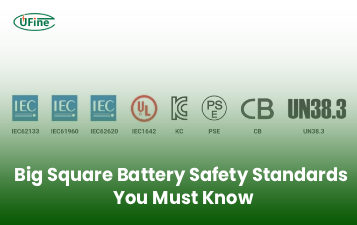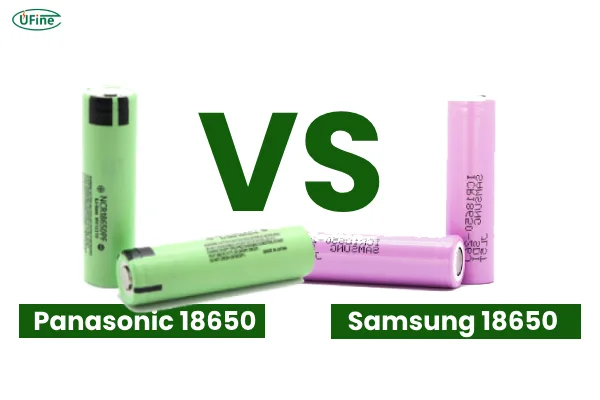
- Part 1. Introduction to 18650 batteries
- Part 2. Overview of Panasonic 18650 battery
- Part 3. Overview of Samsung 18650 battery
- Part 4. Cell chemistry comparison
- Part 5. Capacity & energy density
- Part 6. Discharge rate & current output
- Part 7. Cycle life & durability
- Part 8. Safety features & protection
- Part 9. Performance in real applications
- Part 10. Price comparison and value
- Part 11. OEM, rebranding, and authenticity risks
- Part 12. Environmental and manufacturing considerations
- Part 13. Which one should you choose?
The 18650 lithium-ion battery has become a global standard for high-performance energy storage across multiple industries—from consumer electronics and power tools to electric vehicles and solar energy systems. Among the top names in this field, Panasonic and Samsung stand out as two of the most reliable and innovative manufacturers of 18650 cells.
But what exactly sets Panasonic 18650 batteries apart from Samsung 18650 batteries? Whether you’re an engineer designing a new device, a business sourcing components, or a tech enthusiast building your own power pack, this detailed comparison will help you understand the technical, functional, and commercial differences between the two.
Part 1. Introduction to 18650 batteries
An 18650 battery is a rechargeable lithium-ion cell with a cylindrical shape—18mm in diameter and 65mm in length. These batteries are widely used because of their high energy density, long cycle life, and strong thermal stability.
Among many brands in the market, Panasonic and Samsung SDI are consistently recognized for their advanced technology, stringent quality control, and reliable performance. In recent years, many OEMs and custom battery manufacturers like Ufine Battery have also begun integrating top-tier 18650 cells into custom battery packs for applications ranging from electric bicycles to industrial sensors. In addition, Ufine Battery also provides other brands or our own 18650 batteries, which have more cost and fast delivery advantages. Contact us now!
Part 2. Overview of Panasonic 18650 battery
Panasonic is a Japanese electronics giant with a strong legacy in battery manufacturing, particularly in the electric vehicle space (notably with Tesla). Their 18650 cells are known for:
- High capacity (especially NCR series)
- Stable discharge characteristics
- Excellent cycle life
Popular Panasonic 18650 models include:
- NCR18650B – 3400mAh, 4.9A continuous discharge
- NCR18650GA – 3500mAh, 10A continuous discharge
- NCR18650PF – 2900mAh, 10A discharge with good balance of capacity and rate
Panasonic’s batteries are optimized for energy density, making them ideal for energy storage systems, laptops, and long-range EV packs.
Part 3. Overview of Samsung 18650 battery
Samsung SDI, the battery arm of the South Korean tech conglomerate, is equally respected in the lithium-ion market. Their 18650 cells are often favored for high discharge rates and power delivery.
Key Samsung models include:
- INR18650-25R – 2500mAh, 20A continuous discharge
- INR18650-30Q – 3000mAh, 15A discharge, balanced performance
- INR18650-35E – 3500mAh, 8A discharge, high capacity
Samsung’s chemistry tends to favor power output, making their cells excellent for applications such as power tools, drones, and vaping devices.
Part 4. Cell chemistry comparison
Both manufacturers use slightly different lithium-ion chemistries:
- Panasonic NCR series – Uses a modified LiNiCoAlO2 (NCA) or LiNiMnCoO2 (NMC) blend, which offers high capacity with safety.
- Samsung INR series – Uses Nickel Manganese Cobalt Oxide (NMC), balancing energy and power.
Panasonic tends to lean toward higher capacity with moderate discharge, while Samsung emphasizes higher discharge capability, even if that slightly compromises total capacity.
Part 5. Capacity & energy density
| Model | Capacity (mAh) | Energy Density | Brand |
|---|---|---|---|
| NCR18650B | 3400 | Very High | Panasonic |
| NCR18650GA | 3500 | Very High | Panasonic |
| INR18650-30Q | 3000 | High | Samsung |
| INR18650-35E | 3500 | High | Samsung |
If your application demands longer run time, Panasonic cells like the GA or B are ideal. But if you’re looking for a blend of power and capacity, Samsung’s 30Q and 35E are also competitive options.
Part 6. Discharge rate & current output
High-drain applications require batteries that can safely deliver large currents. Here’s how they compare:
| Model | Max Continuous Discharge | Brand |
|---|---|---|
| NCR18650B | 4.9A | Panasonic |
| NCR18650GA | 10A | Panasonic |
| INR18650-25R | 20A | Samsung |
| INR18650-30Q | 15A | Samsung |
For high-power applications such as RC models, e-bikes, and power tools, Samsung’s 25R is often the better choice. For steady energy discharge over time, Panasonic’s GA or PF excels.
Part 7. Cycle life & durability
Panasonic is widely regarded for excellent long-term cycle performance, especially in moderate-load conditions. Samsung also performs well, particularly under higher-drain use cases.
- Panasonic NCR18650B/GA: 500–800 cycles (with mild discharge rates)
- Samsung 25R/30Q: 300–500 cycles (under higher load conditions)
Battery longevity also depends heavily on charge/discharge rates, ambient temperature, and cell balancing in packs. That’s why working with a custom battery provider like Ufine Battery ensures you get battery solutions that match your exact performance and longevity requirements.
Part 8. Safety features & protection
Both brands build in multiple safety mechanisms:
- CID (Current Interrupt Device) – Prevents overpressure
- PTC (Positive Temperature Coefficient) – Protects against short circuits
- High-quality separators and vent mechanisms
However, neither Panasonic nor Samsung provides PCB-protected 18650s in their base models. If you need protected cells or complete battery packs with overcharge, over-discharge, and short-circuit protection, companies like Ufine Battery offer customizable solutions with integrated PCM/BMS modules.
Part 9. Performance in real applications
Let’s break it down by use case:
| Application | Recommended Brand & Model |
|---|---|
| Flashlights | Samsung 30Q / Panasonic GA |
| Power Tools | Samsung 25R |
| Laptops | Panasonic NCR18650B |
| E-bikes | Panasonic PF / Samsung 30Q |
| Drones | Samsung 25R |
| Solar Storage | Panasonic GA / Samsung 35E |
Ufine Battery often integrates both Panasonic and Samsung 18650 cells into their custom lithium battery packs depending on customer needs, whether it’s for industrial monitoring, GPS trackers, medical instruments, or backup power systems.
Part 10. Price comparison and value
Price can vary based on quantity, batch, and source. Generally:
- Panasonic high-capacity cells tend to be slightly more expensive
- Samsung cells are more cost-effective for high-discharge applications
For large-volume orders or when custom specifications are involved, partnering with a manufacturer like Ufine Battery can significantly reduce procurement cost by bundling customization, testing, and fast delivery.
Part 11. OEM, rebranding, and authenticity risks
Due to the popularity of both brands, counterfeit 18650 batteries are a serious problem in the open market.
- Genuine Samsung and Panasonic cells are rarely sold as individual retail units.
- Many low-cost batteries labeled as “Samsung 18650” or “Panasonic 18650” are often rewrapped lower-quality cells.
When sourcing batteries, it’s critical to work with reputable suppliers. Ufine Battery sources genuine brand-name cells directly from authorized channels, and can also provide custom-labeled solutions using verified Panasonic or Samsung cores.
Part 12. Environmental and manufacturing considerations
Both brands maintain high standards of sustainability in production. However:
- Panasonic operates many of its factories in Japan and China.
- Samsung SDI manufactures in South Korea, China, and Malaysia.
For projects requiring RoHS, UN38.3, or MSDS certification, Ufine Battery can provide complete documentation and custom manufacturing using certified Panasonic or Samsung 18650 cells, ensuring compliance for both domestic and international projects.
Part 13. Which one should you choose?
The decision between Panasonic and Samsung 18650 batteries ultimately depends on your application needs:
- Choose Panasonic 18650 if:
- You need maximum capacity
- Your device draws moderate current
- You prioritize cycle life and energy density
- Choose Samsung 18650 if:
- Your application demands high discharge rates
- You want a balance between power and affordability
- You’re powering tools, drones, or RC models
If you’re not sure which to choose, or if you need a custom battery pack for your device or project, Ufine Battery offers full-service support including:
- Professional cell selection (Panasonic, Samsung, or others)
- Custom sizing, voltages, and pack configurations
- Integrated protection circuitry and enclosure design
- Fast prototyping and volume production
Explore more at UfineBattery.com or consult with their engineering team for a tailored lithium battery solution.
Related Tags:
More Articles

Big Square Battery Safety Standards You Must Know
Learn key safety standards for big square batteries to avoid fire risks, shipping delays, and compliance issues in EV, industrial, and energy storage projects.
Big Square Battery Applications in Solar & Industrial Equipment
Big square batteries deliver high capacity, stable output, and long life for solar, industrial, and backup power. Explore key uses and advantages.
Big Square Battery vs Cylindrical Battery: Complete 2025 Guide for EVs, ESS & Industrial Devices
Choosing the right battery is key for designers and engineers. Compare big square vs cylindrical batteries to find the best fit for your application.
How to Choose the Right Big Square Battery for Your Device?
If you’re choosing a big square battery for EVs, solar, or mobility devices, this guide helps you pick the right solution for real-world needs.
Big Square Battery Complete Guide: Types, Uses & Buying Tips
If you are choosing a big square lithium battery for EVs, solar, RVs, or AGVs, this guide helps you select the right NMC, LFP, or LTO solution with examples.



